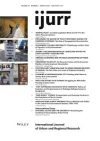The current president of the Philippines, Rodrigo Duterte, has been called a populist, but his populism is of a particular sort. Historically, Philippine populists draw a line between rich and poor. Duterte’s line cuts between discipline and disorder. It separates law-abiding citizens on the one hand from rule-breakers and benders, the corrupt and criminal, on the other. Since his inauguration in June 2016, Duterte’s administration has been controversial to say the least. He has prosecuted a ruthless drug war; according to Human Rights Watch, one that has claimed more than twelve thousand lives in two years. He has made a series of moves effectively curtailing democratic latitude, including arresting the Human Rights Commissioner, threatening his vice-president and ombudsman, suing political opponents, and banning a critical media outlet from the presidential palace. In a symbolic move, he authorized the burial of the late dictator Ferdinand Marcos in the Heroes Cemetery. Duterte’s approval rating, nevertheless, remains extraordinarily high, at 81% as of December 2018 (Pulse Asia 2019).
Although support for Duterte is widespread and cuts across class and regional lines, it is also true that his support is particularly strong in Metro Manila and among the upper and middle class. After Mindanao, where Duterte’s bailiwick, Davao City, is located, his support is highest in Metro Manila. In the year preceding the election, the percentage of people in Manila preferring Duterte for president jumped from 7 to 40%. He won Metro Manila with 44% of the vote—more than double the votes garnered by the second-place finisher.
The upper and middle class have been Duterte’s leading supporters. In the run-up to the election, they showed the strongest support for his candidacy early on and throughout the race. The exit poll from the 2016 presidential election shows Duterte to have won the most votes among the upper classes and college graduates (SWS 2016). This support is puzzling if we consider the middle class to represent “a natural constituency for democracy” (Bautista 2001, 188) and given the Philippine middle class’ historic role in democratization. It is even more puzzling that Duterte’s middle class supporters stuck with him once the autocratic character of his administration had become apparent. After two years in office, surveys show that the upper classes and college graduates continue to express high levels of satisfaction with Duterte’s administration. How do we explain their support, in Metro Manila particularly?
In this piece, I will point to the role of the city in shaping the political subjectivity of the upper and middle classes. Metro Manila represents a distinct sociological environment. Within this environment, I will argue, the upper and middle classes come to view order and disorder in particular ways. These views have conditioned their receptivity to Duterte’s appeals. This argument, which I can only sketch here, is based on several years of ethnographic research on the middle class and poor in Metro Manila between 2009-2014.
A Distinct Sociological Environment
Metro Manila is distinguished from the rest of the country by the concentration of upper- and middle-class residents. The metro region contains 28% of the country’s middle-income population and 46% of its high-income population (Virola et al. 2013). If we include the regions to the north and south of Metro Manila, the proportion of middle-income residents doubles to nearly 60%. As defined by income, the population of Metro Manila is 54% middle class, 0.41% upper class, and 46% lower class. This is a rarefied demography compared with the rest of the Philippines. In virtually every other region in the country, the lower class comprise between 70 to 96% of the population.
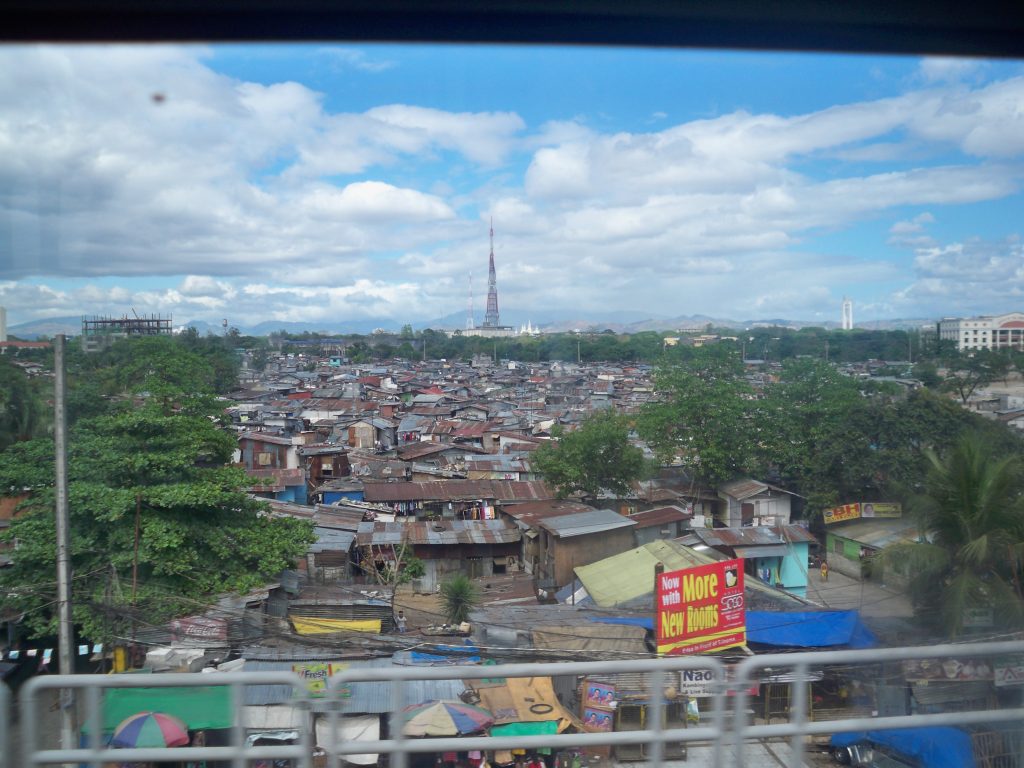
A view of San Roque from the metrorail. Photo: Marco Garrido.
The concentration of upper and middle class (hereafter, just middle class) in Metro Manila leads to an intensity of interactions between (1) them and the urban poor and (2) among themselves. These interactions serve to clarify a middle-class identity as well as to imbue it with a specific moral content. Specifically, they shape perceptions of disorder and a vision of order.
Perceptions of Disorder
Metro Manila is divided between the urban middle class and poor, but not simply because it contains the two populations. The two populations come to be defined as class groups interactionally within the context of the city. Their spatial organization plays a significant role in this process.
First, the urban middle class and poor tend to be identified with “enclaves” and “slums” respectively. I use the word slum advisedly as a general term for low-income settlement. As a number of scholars have pointed out, the term masks considerable heterogeneity. Despite such heterogeneity, however, the term has analytical coherence in relation to upper- and middle-class spaces, or enclaves. Enclaves include residential subdivisions (“villages”) and condominiums as well as exclusive malls and commercial centers. The spatialization of the urban poor and middle class in slums and enclaves makes class boundaries sharper. Their residents come to be seen as belonging to different and unequal groups of people, as squatters and “villagers.”
Secondly, slums and enclaves are interspersed throughout the metro. Proximity facilitates interaction between their residents in the contexts of employment, civic association, benefaction, and the urban environment. This interaction, however, tends to be categorically unequal. It usually involves one side imposing spatial boundaries on the other. Slum residents are systematically excluded from middle class spaces, or their presence within these spaces is circumscribed or surveilled.
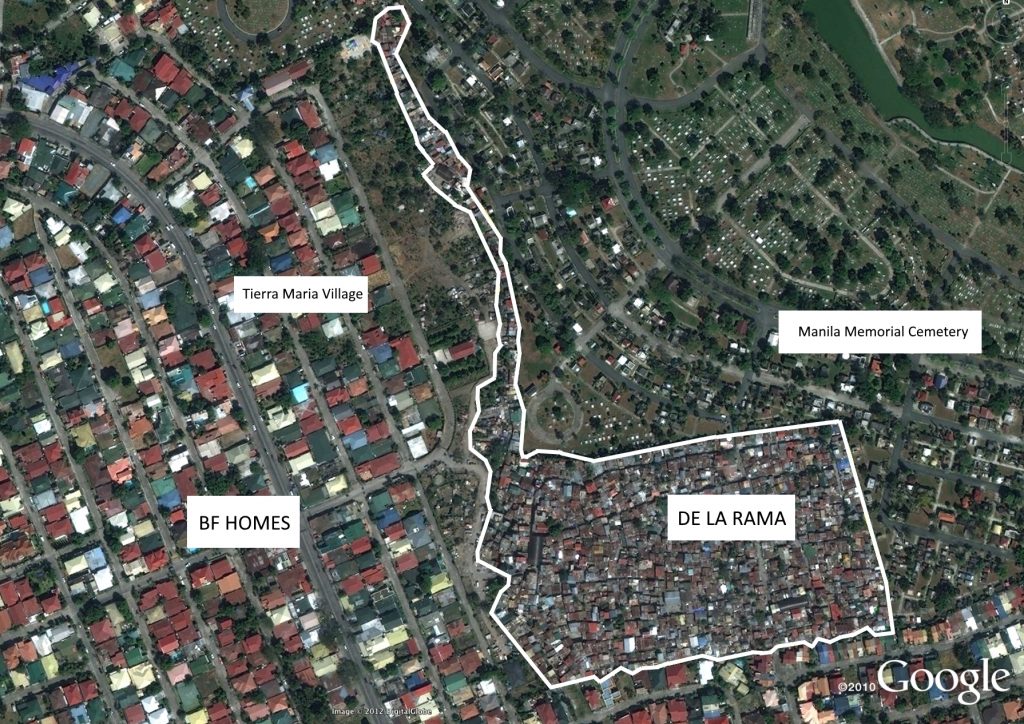
De la Rama, a slum area, is sandwiched between a middle class subdivision (BF Homes) and Manila Memorial Cemetery. Photo: Marco Garrido.
In other words, the ecology of Metro Manila promotes sharper class boundaries and greater unequal interaction across these boundaries. As a result, class relations have become more fraught than ever. The urban poor conceive a powerful sense of discrimination. These feelings are highly susceptible to politicization, as I discuss elsewhere (Garrido 2019). The middle class, meanwhile, associate the urban poor with encroachment, crime, and populism. They view them as agents of disorder. These feelings too, I will suggest, are liable to politicization.
The upper and middle class also interact regularly among themselves. The intensity of their interaction is a product of their concentration in Metro Manila and a few other cities in the Philippines. Concentration enables the development of a civil society in Partha Chatterjee’s (2004) sense, that is, as limited to the associational activities of people possessing a certain amount of property and education. Civil society thus defined represents something of a bourgeois public sphere.
I would distinguish between two kinds of middle-class interaction; one, interactions with “corrupt” others. Corrupt others are people who flout valued rules: bureaucrats who abuse public office for personal enrichment or powerful others who use their money, connections, or position to gain advantage or escape sanction. The middle class draw moral boundaries against such actors and practices. Two, the middle class interact among themselves in ways that serve to corroborate a common sense of disorder. They come together in the context of various forms of association and build up a common interpretation of their predicament. Here they draw moral boundaries around the group. Corroboration is intensified by the relative closure of upper- and middle-class circles both socially and spatially. These two kinds of boundary work demarcate a distinctly middle-class moral stance.
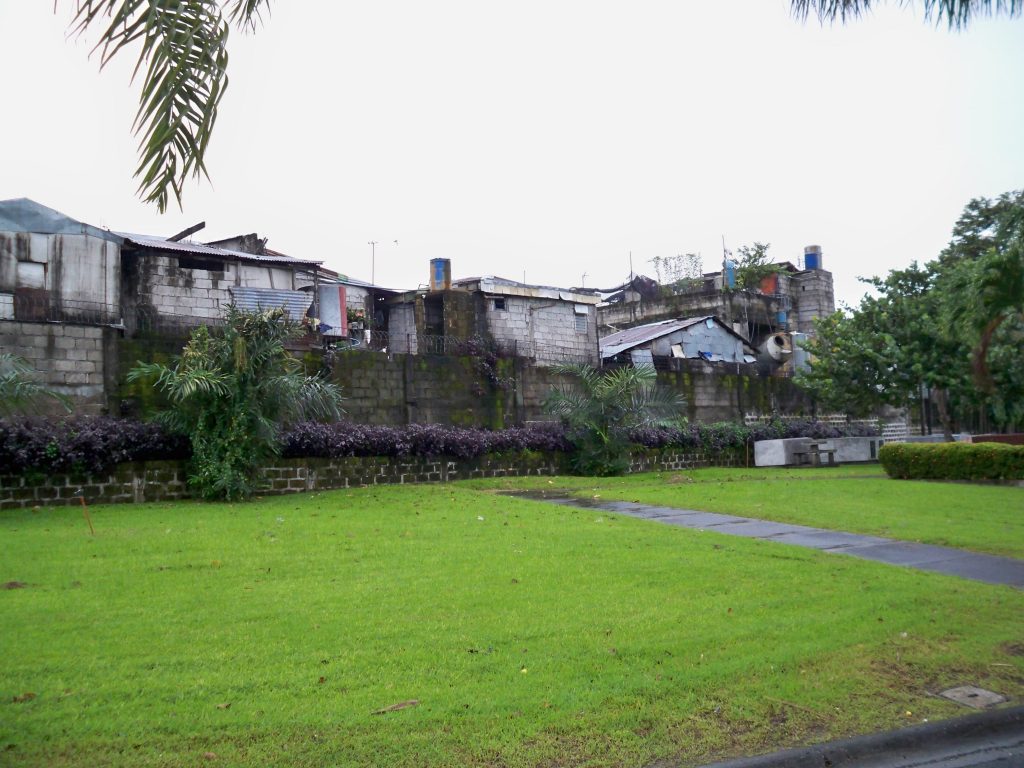
The wall separating the Manila Memorial Cemetery from De la Rama. Photo: Marco Garrido.
Middle class interactions with the urban poor and among themselves lead them to identify particular sources of disorder. In my research, informants pointed to corruption, rule-bending, informal settlement, and populism (of the traditional kind). These sources of disorder reflect the middle class’ social position. They threaten their interests as property owners (informal settlement), as business owners and taxpayers (corruption), and as constituents (populism). The upper and middle class may engage in rule bending, but most of them are not completely insulated from the vagaries of social power and periodically find themselves to be the ones bypassed or overruled. These sources, moreover, offend a normative sensibility shaped by middle-class modes of socialization, including higher education, professional occupation, civic association, international travel, and the consumption of English-language media.
The urban poor may share an assessment of disorder, but they understand it differently. Their different social position commits them to different patterns of interaction resulting in different experiences of disorder. Discrimination for being poor and informal plays a significant part in their assessment. Consequently, they are more likely to associate disorder with the “rich” and thus more susceptible to traditional populist appeals.
A Vision of Order
The city also plays a role in shaping a distinctly middle-class vision of order. The extended urban environment, particularly as transformed by neoliberal restructuring, provides numerous models of order. Informants point to certain cities, gated communities, corporate enclaves, and special economic zones within and around the metro region. They point to exceptional cities within the Philippines (e.g., Duterte’s Davao) or to countries like Singapore. They see these places as physically and culturally distinct from their surroundings. They believe that valued rules are more likely to be enforced within them. Informants described them as “pockets of discipline.”
Foucault (1998) called such places heterotopias. Heterotopias are real places yet somehow distinguished from the space around them—in this case, by their relative order—and thus function as “counter-sites.” Foucault likened their effect to that of a tinted mirror. Heterotopias enable people to imagine themselves on the other side of the mirror, that is, belonging inside them. This makes being where they actually are harder to bear.
These pockets of discipline are generally seen as the work of “strong leaders”: Lee Kwan Yew, Dick Gordon (Subic), Bayani Fernando (Marikina City), Duterte (Davao City). Informants credit these leaders with bringing people’s behaviors in line with valued rules, usually by scrupulously punishing transgressions.
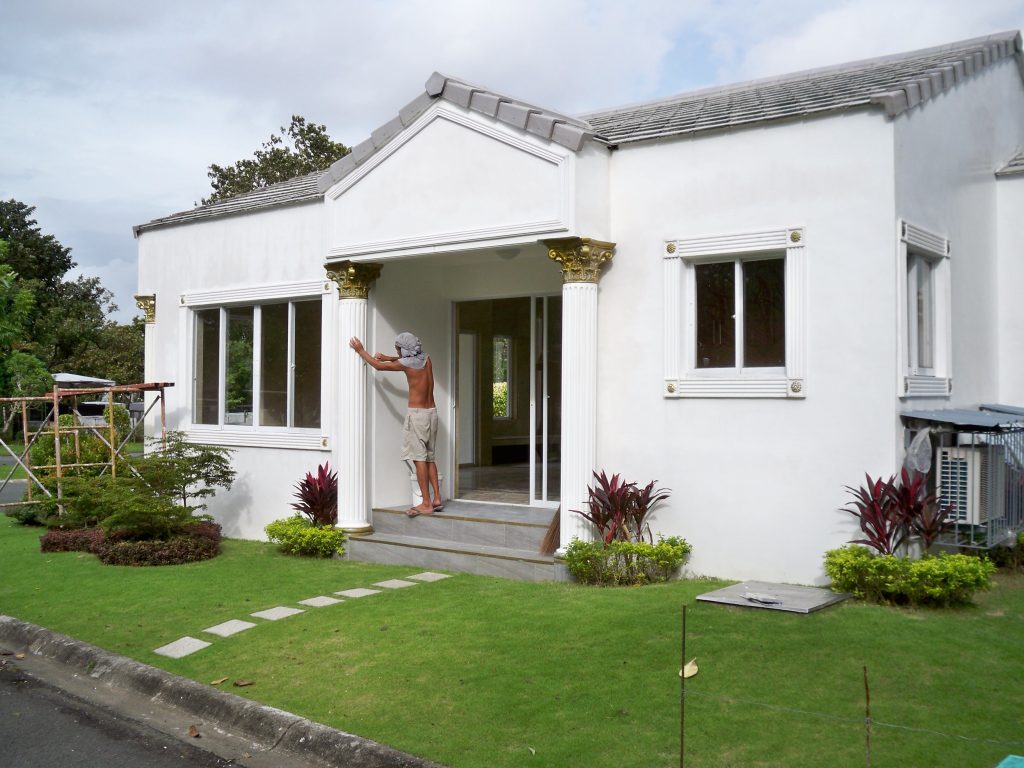
A caretaker tending a mausoleum in the cemetery. Photo: Marco Garrido.
The middle class are susceptible to these models because they belong to these places, or because they possess the means to avail of and participate in them. They live in gated communities, work in corporate enclaves and central business districts, shop in upscale malls, and play in exclusive compounds. With so much of their lives spent within private, cultivated spaces, it is no wonder the public city appears to them a wilderness in need of being brought to heel. The middle class can afford to vacation in Subic, a special economic zone and resort area, or to visit Singapore. Both were given as places where people actually follow the rules. Both were cited as models for what the country could one day become. In other words, the middle class do not need to conjure utopias out of thin air. They can point to the pockets of discipline all around them and within their reach. It matters, of course, that they see these pockets as being the work of autocratic leaders.
Waiting for Duterte
What do these distinctly urban experiences mean for the politics of the urban middle class? I would argue that they condition a receptivity to “strong leaders.” I would say that the middle class have been waiting for someone like Duterte for some time now.
Duterte fits the archetype of the strong leader as drawn by informants. He is seen as imposing discipline. The drug war, in particular, represents a performance of discipline made all the more effective by its spectacular quality. Its significance, I would argue, is primarily symbolic. Drugs, after all, are not the problem Duterte has made them out to be. The government’s own figures belie his claims. In his first State of the Nation Address, Duterte estimated that the Philippines had 3.7 million drug addicts. Two months later, the Dangerous Drugs Board declared that it had 1.8 million current drug users, not even addicts (Quimpo 2017, 147). In light of these figures, Quimpo concluded that Duterte inflated the drug issue in order to justify a crackdown that served to burnish his reputation for being “a man of action.”
I would suggest that the drug war is targeted not just at drug dealers and users but at a disorderly public generally. If a normally critical civil society has largely abided it, this is because many in civil society cleave to perceptions of disorder. Many subscribe to a vision of order as being imposed from above and not without great human cost. I have argued that these perceptions take shape within the distinct sociological environment of Metro Manila. This environment is distinguished by the intensity of the middle class’ interactions with the urban poor and among themselves. I have pointed to the role of the city in conditioning their reception of Duterte.
Marco Garrido is Assistant Professor of Sociology at the University of Chicago. His research focuses on democratic politics and democratic recession, social class, and urban space and structure. He is the author of The Patchwork City: Class, Space, and Politics in Metro Manilla (University of Chicago Press, 2019), as well as numerous research articles.
All essays on Political Geographies of Right Wing Populism
Introduction
Liza Weinstein
Spatial Configurations of Right-Wing Populism in Contemporary Germany
Nitzan Shoshan
Waiting for Duterte
Marco Garrido
Brazil’s Political Peripheries and the Authoritarian Style
Benjamin H. Bradlow
Regional Liberals and the Urban Anxieties of Indian Populism
Mona G. Mehta
The Contested City as a Bulwark against Populism: How Resilient is Istanbul?
Berna Turam
Related IJURR articles on Political Geographies of Right Wing Populism
‘Get out of Traian Square!’: Roma Stigmatization as a Mobilizing Tool for the Far Right in Timişoara, Romania
Remus Creţan Thomas O’brien
Revitalizing the City in an Anti‐Urban Context: Extreme Right and the Rise of Urban Policies in Flanders, Belgium
Pascal de Decker, Christian Kesteloot, Filip de Maesschalck and Jan Vranken
Using the Past to Construct Territorial Identities in Regional Planning: The Case of Mälardalen, Sweden
Luciane Aguiar Borges
Le Pen’s comeback: the 2002 French presidential election
Nonna Mayer
The Urban Politics and Subject Formation
Lisa Hoffman
How Globalization Really Happens: Remembering Activism in the Transformation of Istanbul
Christopher Houston
The Postcolonial City and its Displaced Poor: Rethinking ‘Political Society’ in Delhi
Sanjeev Routray
The Ideology of the Dual City: The Modernist Ethic in the Corporate Development of Makati City, Metro Manila
Marco Garrido
How Interspersion Affects Class Relations
Marco Garrido
The Citizen Participation of Urban Movements in Spatial Planning: A Comparison between Vigo and Porto
Miguel Martínez
Hamburg’s Spaces of Danger: Race, Violence and Memory in a Contemporary Global City
Key Macfarlane & Katharyne Mitchell
Experiences of Urban Militarism: Spatial Stigma, Ruins and Everyday Life
Silvia Pasquetti
© 2019 THE AUTHOR. INTERNATIONAL JOURNAL OF URBAN AND REGIONAL RESEARCH, PUBLISHED BY JOHN WILEY & SONS LTD UNDER LICENSE BY URBAN RESEARCH PUBLICATIONS LIMITED
This is an open access article under the terms of the Creative Commons Attribution-NonCommercial-NoDerivs License, which permits use and distribution in any medium, provided the original work is properly cited, the use is non-commercial and no modifications or adaptations are made.
